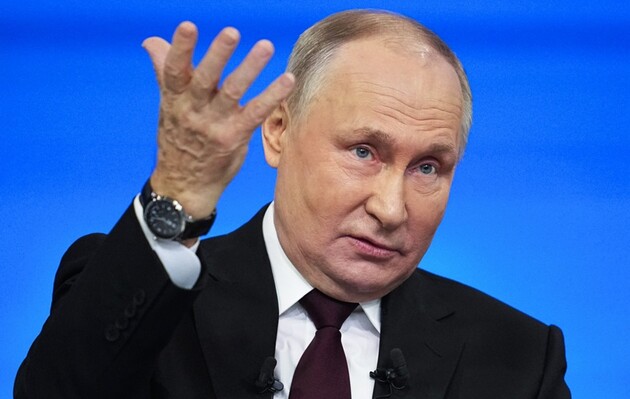Putin Set His Sights on Europe. Which NATO Countries Will He Attack After Ukraine?
During Russia's massive missile attack on Ukrainian cities, Poland scrambled two pairs of F-16 fighters. So far, the Poles have limited themselves to this. But they are bracing themselves for the worst. After all, the countries of Western and Eastern Europe may be the next to fall prey to Russia's aggression.
For some, such a course of events probably seems to be an unlikely scenario since these countries are under the umbrella of Article 5 of the North Atlantic Treaty. But for many experts and politicians, Russia’s large-scale invasion of Ukraine, which was “protected»” by the assurances of the Budapest Memorandum, looked equally unlikely. However, an attack on one of the NATO countries is a more realistic scenario: Putin has set himself a goal to restore the Russian Empire and reshape the international order.
And so far nothing indicates that he has abandoned these plans.
Not all EU and NATO countries have yet come to realize the danger, although in the Baltic and Scandinavian countries, Poland, the Czech Republic, and the Netherlands, the military and politicians have realized the reality of the threat. For instance, the commander-in-chief of the army of the Netherlands, General Martin Wijnen, has recently stated that the Kingdom should prepare itself for a possible military confrontation with Russia. “We should not think that our safety is guaranteed only because we are 1,500 kilometers away from them,” the general noted.
However, Putin's most likely military target today is not the Netherlands, Finland or Poland, but the Baltic states. On the one hand, the Russian leadership cannot forgive Latvia, Lithuania and Estonia (one of the first republics of the USSR to declare their independence) for the events of 1990. On the other hand, the Kremlin fears the transformation of the Baltic Sea into an “internal NATO sea” after Finland and Sweden join the Alliance. To “open a window to Europe,” Putin is ready to follow in Stalin's footsteps and occupy the Baltic states.
The scenario of a Russian attack on these Baltic countries looks realistic not only because they have weak armed forces, but also because there is no 100% certainty that NATO will apply Article 5. The Kremlin belligerence is fueled by both the prospect of Donald Trump's return to the White House and the threat of the US leaving NATO, as well as the apparent organizational and technical unpreparedness of the West for a prolonged armed confrontation in the conditions of a modern war.
As it turned out, states members of the Alliance, which do not even participate in the hostilities, do not have enough ammunition and equipment to fully support Ukraine in a high-intensity war. Restarting the defense industry requires time and money. Our Western partners are slowly bestirring themselves, stepping up the production of tanks, air defense systems, artillery and ammunition, which are so necessary for us to confront the aggressor effectively. And most NATO countries have not yet reached the stated level of military spending of 2% of GDP.
Putin's confidence in his own strength is growing against the background of political disagreements in the US and the EU regarding support for Ukraine and increasingly loud calls for negotiations with Russia and freezing the conflict. Of course, in Moscow, they cannot help but rejoice at the results of polls of Western Europeans, which show an extremely low willingness of the population of EU countries to defend their country in the event of an attack.
For instance, according to the results of polls by the German publication Stern and the Polish Rzeczpospolita, only one in sixth Germans (17%) and Poles (15%) are ready to fight for their country. At the same time, 19% of Germans said that they are probably ready to defend the country, while a staggering 61% (!) replied they were “probably” or “under no circumstances” ready. In Poland, 29% are ready to volunteer, for example, in a hospital, and 15.7% – in the army, but as volunteers, 25.5% of respondents intend to leave for a safe regions of the country, and 11.9% plan to move with their family abroad. 22% will not do anything, and 11.6% do not know what they will do.
The Kremlin's hands are untied by the West's lack of determination to respond to Russian missiles and drones flying into Poland and Romania. Of course, one cannot rule out an accidental rocket attack on their territory. But there are also suspicions that in this way Russia conducts both a practical reconnaissance of the air defense capabilities of NATO member countries and a test of the country's political leadership for the ability to respond to threats appropriately.
In response to similar incidents, Warsaw and Bucharest still prefer to summon ambassadors and express their concern: Washington imposes an anti-escalation model of behavior on NATO's eastern wing.
Against this background, Gabrielius Landsbergis, Minister for Foreign Affairs of Lithuania, warns the allies against repeating historical mistakes and urges the West not to wait for the “Pearl Harbor effect.”
The German Council on Foreign Relations (DGAP) believes that if the war in Ukraine is frozen, Russia will need 6 to 10 years to redirect its current production to rebuild its armed forces to the level where it can attack NATO. Moreover, the combat power of the Russian army will exceed the current deterrence potential of the Alliance in a conventional war in Europe. German experts suggest that NATO members in Europe have five to nine years to get ready to repel a possible Russian attack.
In turn, Warsaw predicts that they have three years to prepare for such a scenario. According to Jacek Severy, Head of the Bureau of National Security, the Russian military-industrial complex works in three shifts and can restore the Russian army in the next three years. “If we want to avoid war, the NATO countries on the eastern flank must accept a shorter, three-year time horizon to prepare for confrontation. This is the time when capabilities should be created on the eastern flank, which would be a clear signal for deterring aggression,” Severa said.
However, these estimates are overly optimistic: Europe does not have five or three years. Ukraine believes that a military campaign against the Baltic states can begin as early as 2025, and it is not necessary to freeze the war with Ukraine for an invasion: Putin can start a war on several fronts at the same time.
Albeit reluctantly, Europe is gradually rethinking the threat emanating from Russia. First, under pressure from the United States, European countries have begun to increase their defense spending. Second, under the influence of Russia's aggression against Ukraine, the EU and NATO states have started to wake up from Putin's hypnosis and more realistically assess the risks that the Kremlin is creating. But everything goes very slowly. Europeans themselves can become the next victims of Russia's attack before they know it.
The price for this unwillingness to respond to risks from Russia promptly will be the death of people, the destruction of villages and cities — all that the Europeans are witnessing in Ukraine today. Just witnessing – for now…
Read this article in Ukrainian and russian.
Please select it with the mouse and press Ctrl+Enter or Submit a bug












 Login with Google
Login with Google